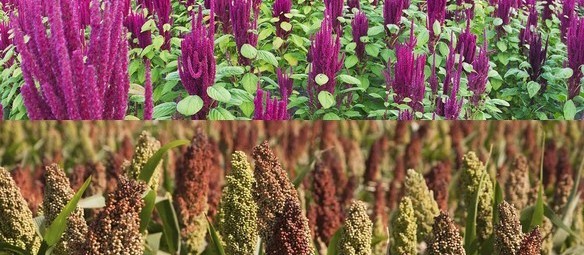For the last week of “Whole Grain Month”, our grains of the week are Sorghum and Amaranth
Special Price for Grain Week (click here to see all grain specials), for all the grains we have featured, will continue through Sept 30 2016.
| Code | Description | Retail | Sale |
| 07033 | Sorghum ORGANIC 42lbs. 6 gal. Bckt. | $59.25 | $53.32 |
| 07036 | Sorghum ORGANIC in 2 lb. Baggie | $5.64 | $4.68 |
| 07035 | Sorghum ORGANIC 7lbs. 1 gal. Pail | $22.27 | $15.36 |
| 02000 | Amaranth ORGANIC 45lbs. 6 gal. Bckt. | $113.08 | $101.77 |
| 02004 | Amaranth ORGANIC in 2 lb. Baggie | $10.04 | $8.33 |
| 02002 | Amaranth ORGANIC 7lbs. 1 gal. Pail | $37.67 | $25.99 |
One of my favorite gluten free grain combination is sorghum and amaranth. The flavor of sorghum flour is mild and very adaptable. Sorghum flour is the closest in flavor to wheat flour therefor can easily be substituted in quick bread like muffins, pancakes, waffles and cookies, making an easy gluten free version, for those who need it.
Amaranth on the other hand has a slightly grassy, peppery or earthy flavor and works best when combined with other flours and masked with chocolate or citrus. Its starchy almost gummy texture compliments the slightly drier texture of sorghum to make the perfect combination for deliciously flavored and textured quick breads. Whether you need to be gluten-free or not, the Lemon Poppy Seed Bread from the Essential Home Ground Flour Book by Sue Becker below will become a family favorite.
Nutritionally, these two grains are powerhouses.
Like most grains, sorghum supplies an abundance of B vitamins as well as minerals, such as magnesium, calcium, iron and potassium. is a significant source of both protein and fiber. It has as much as 16% more protein than most grains and a whopping 12 grams of fiber per serving. Sorghum is a rich source of many phytochemicals and antioxidants and shows great potential in improving human health as well as cancer prevention. Research studies have found that sorghum supplies nutrients that support good bone density, regulate blood sugar and cholesterol levels, and improve digestion. Worldwide, about 50% of sorghum goes to human consumption but unfortunately, in the US most of the sorghum is used for animal feed or other uses in commercial industries. We, the consumer, can help change that by consuming more of this highly nutritious and delicious people food.
Amaranth is actually a pseudo-grain, meaning it is not truly a grain at all. It is the seed of a tall plant with broad green leaves and beautiful, bright colored flowers. Its name is derived from the Greek word, amarantos, which means “never fading” as its bright flowers retain their color, even after cutting and drying. In Asian cultures it is known as “king seed” or “seed sent by God” in recognition of its unique flavor and role as a source of nourishment. Amaranth played a significant role in the Aztec civilization where it was believed to “turn a weak man into a warrior”.
Its reputation as a super food however is not simply based on legend or folklore. Amaranth is a considered a complete protein source, meaning it has all 9 amino acids considered essential for human health and growth, including lysine which is either missing or nutritionally deficient in most true grains. Researchers have further concluded that the protein in amaranth is among the most nutritious vegetable-based protein and is quite comparable to the protein from animal sources.
Amaranth is included in the line-up as a whole grain because its nutritional profile and use as a food throughout history is similar to all other true cereal grains. However, amaranth supplies about three times the amount of calcium as most other grains and is high in magnesium, iron and potassium. It is also the only “grain” found to contain vitamin C. These are just more good reason to look for ways to add amaranth to you diet.
Sorghum and amaranth both can be popped like popcorn (though not as big as popcorn), boiled and eaten as a porridge (amaranth is best added in small amounts with other grains) or ground into flour and used in baking. Below is one of my favorite recipe combining sorghum and amaranth flour. Whether you need to be gluten free or not, you will love the flavor and soft texture of this easy to make bread.
Lemon Poppy Seed Bread – GF, DF
The combination of amaranth and sorghum flour gives the perfect texture to this naturally gluten free bread. The tang of the lemons comes through beautifully with the mild flavored flours. More like a cake than a bread, this will become a family favorite whether you need to be gluten free or not.
Makes 6-8 mini loaves or 12 muffins
Preheat oven to 375F
Mini loaf pans or muffin pans, greased or lined with paper
• 3/4 cup amaranth flour
• 3/4 cup sorghum flour
• 1/2 tsp baking powder
• 1/2 tsp baking soda
• 1/2 tsp salt
• 1 tbsp poppy seeds
• Zest of 1 lemon
• Juice of 1 lemon
• 1 cup light evaporated cane sugar
• 1/2 cup olive oil
• 2 eggs
• 1 ripe banana, mashed
• 2 tsp lemon extract
In large bowl, combine amaranth flour, sorghum flour, baking powder, baking soda, salt, poppy seeds and lemon zest.
In the bowl of an electric mixer, beat lemon juice, sugar, olive oil, eggs, banana and lemon extract until fluffy.
On low speed, add the flour mixture 1/2 cup at a time, until thoroughly combined.
Scoop batter into prepared mini loaf pans or muffin pans. Bake 20-25 minutes.
Let cool for 5 minutes before removing from the pan.
Tip: These are perfect baked as mini-muffins. Just the right bite of lemony sweetness. Makes about 30 mini-muffins.


